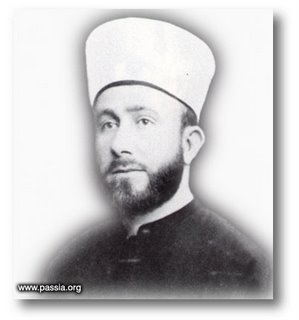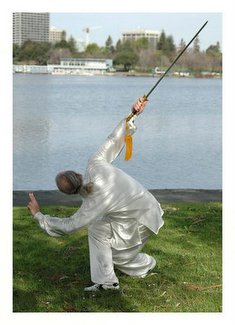And we collectively breathe a sigh of relief when the mushroom cloud is barely averted. And then the pundits of the blogosphere engage in heated battles, playing the blame game, fighting over the specifics that brought this labyrinthine dynamic to caterwauling birth.
There has always been a long-standing hatred between Arabs and Jews that dates back to Abraham’s choice of an heir. Ahmed Osman observes this in his book The Hebrew Pharaohs of Egypt: The Secret Lineage of the Patriarch Joseph, and feels that it stems to when Joseph was the chief advisor for Amenhotep III and Ankhenaton supposedly was Moses’ cousin.
But we can look closer than that. There was a defining instant in history that, I feel, stoked the fires of fanaticism into the firestorm we feel today.
This is one of the tinder bearers of that conflagration [click on the picture for the link]:

"Husseini, Amin al- 1896?–1974, Arab political and religious leader. He was inveterately opposed to the creation of a Jewish state in Palestine, and, suspected of complicity in anti-Jewish riots in Jerusalem (1920), he fled to avoid punishment. He returned under an amnesty and was appointed Grand mufti of Jerusalem by the British in 1921. He fled (1937) to Lebanon after being arrested for provoking violence between Arabs and Jews. Just before World War II, Husseini moved on to Iraq. After the abortive pro-Axis Iraqi revolt of 1941, he was flown to Rome. Then, in Berlin, Husseini broadcast Nazi propaganda and helped recruit Arab supporters for the Germans. In 1946 the mufti, escaping from house arrest near Paris, arrived in Egypt, where he lived until the early 1960s, when he moved again to Lebanon. Also called Haj Amin al-Husseini, he retired from public life after serving as president of the 1962 World Islamic Congress, which he had founded in 1931."
Also:
"Haj Amin al Husseini’s anti-semitism is reported by several of his contemporaries, historians having studied his biography or Nazism, journalists and politicians"
And:
"Husseini soon became an honored guest of the Nazi leadership and met on several occasions with Hitler. He personally lobbied the Führer against the plan to let Jews leave Hungary, fearing they would immigrate to Palestine. He also strongly intervened when Adolf Eichman tried to cut a deal with the British government to exchange German POWs for 5000 Jewish children who also could have fled to Palestine. The Mufti's protests with the SS were successful, as the children were sent to death camps in Poland instead. One German officer noted in his journals that the Mufti would liked to have seen the Jews "preferably all killed." On a visit to Auschwitz, he reportedly admonished the guards running the gas chambers to work more diligently. Throughout the war, he appeared regularly on German radio broadcasts to the Middle East, preaching his pro-Nazi, anti-Semitic message to the Arab masses back home.
Sami al-Joundi, one of the founders of the ruling Syrian Ba'ath Party, recalls: "We were racists. We admired the Nazis. We were immersed in reading Nazi literature and books... We were the first who thought of a translation of Mein Kampf. Anyone who lived in Damascus at that time was witness to the Arab inclination toward Nazism."These leanings never completely ceased. Hitler's Mein Kampf currently ranks sixth on the best-seller list among Palestinian Arabs. Luis Al-Haj, translator of the Arabic edition, writes glowingly in the preface about how Hitler's "ideology" and his "theories of nationalism, dictatorship and race… are advancing especially within our Arabic States." When Palestinian police first greeted Arafat in the self-rule areas, they offered the infamous Nazi salute - the right arm raised straight and upward."
Watch these three films:
And remember this symbol, which fanned the flames of old ancestral hatred, and brought forth the dark blaze that burns our eyes, and breeds the dark shadows dancing upon the world:















8 comments:
Well Mysterio, what is the defining moment???
Don't leave us hanging, man! lol
Tease!
Where's the "expand post" thingamabob?
There we go. Blogger had problems last nite. Hit F5, y'all should see it now.
Well glad to see you fixed your blogger problem. :)
That was very interesting. I did not know that Arabs were so involved with the nazi party, but it makes sense. And thanks for pointing out where the infamous nazi symbol came from. I knew it was an ancient religious one but wasnt sure why they chose that one.
SNTC:
And thanks for pointing out where the infamous nazi symbol came from. I knew it was an ancient religious one but wasnt sure why they chose that one.
Actually, the swastika is a reversal of an ancient Buddhist symbol that represents luck/hope.
Actually, the swastika is a reversal of an ancient Buddhist symbol that represents luck/hope.
I still don't get how turning it sideways makes it a symbol of anti-semitism. Wierd Nazis.
MF:
I still don't get how turning it sideways makes it a symbol of anti-semitism. Wierd Nazis.
It's an old concept. Reversing a symbol changes its meaning. Like the pentagram, or the cross.
Post a Comment